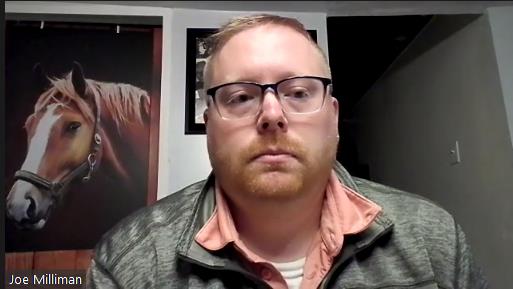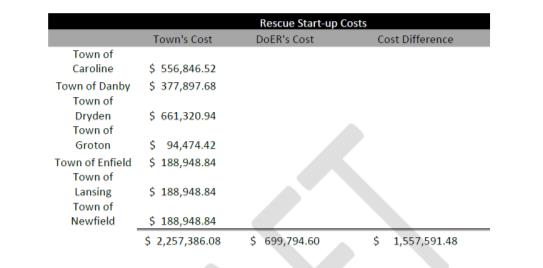Pay-in Flycar Plan draws fire in Newfield
by Robert Lynch, September 29, 2023
Joe Milliman struggled. But really, it wasn’t his fault. The Emergency Services Coordinator for Tompkins County had to work with what he’d been given. And to persuade a tax-wary, Big Government-skeptical hometown audience in Newfield Thursday, what he had wasn’t enough. Clearly, his was a presentation not yet ready for Prime Time.

For more than a half-hour Thursday, Milliman Zoomed into a legally-mandated Public Hearing anchored at the start of the Newfield Town Board’s monthly work session. It addressed Tompkins County’s “Countywide Shared Services Plan.” That plan for 2024 proposes County Government and local towns band together to establish a “Rapid Medical Response Team.” They’d set up a trio of “Flycar” SUV’s, each staffed by an Emergency Medical Technician (EMT) and purposed to respond to medical emergency calls when local fire departments or rescue squads cannot. They’d administer first aid until the ambulance arrives.
This Rapid Response model has been discussed at the County level for more than a year. (This reporter/Councilperson stands among its most ardent supporters.) But now money enters the picture, local money. Most people had assumed that our well-heeled county would bear all of the expense. Now we learn it doesn’t intend to do so. “The County will need to consider cost sharing or other arrangements with municipalities to support ongoing operational expenses for year two and beyond,” the Shared Services Plan’s narrative states bluntly on its first page.
“I’m not opposed to the idea, but if we’re voting on something tonight, I’d vote no,” Newfield Councilperson Christine Seamon told her town’s Thursday hearing.
No votes were taken, nor requested. Yet public sentiment stood clear. Not a single person who spoke at Newfield’s Public Hearing—not Town Board members, not members of the public—supported a County-run flycar system that they, Newfield, would have to chip in to pay for. Town Supervisor Michael Allinger suggested it would be better to pay local people to staff the fire house.
Newfield hearings are often open-and-shut affairs, with zero comments. Thursday’s was anything but that. Public participants and Town Board members peppered Coordinator Milliman with questions and criticism. After the 40-minute Public Hearing had ended and the County Coordinator had Zoomed out, critical comments from the floor continued for another 20 minutes.
“This is a duplication of services,” one questioner told Milliman. “What benefit does the Newfield taxpayer gain from buying into this?”
“Tonight’s presentation was not an operational presentation,” the Emergency Services Coordinator replied. His words didn’t sell.
“If we get out of this, does it still figure into the tax bill?” a questioner posed from the gallery. Of course, the Tompkins County portion of the Rapid Response program would be borne by all County taxpayers. Could local municipalities opt-out of participating? The Shared Services Plan doesn’t discuss that.
In fact, the draft document avoids making even a wildest of estimates about what towns would need to pay-in. And arguably the numbers that the Shared Services Plan does provide do more harm than good.
A tabulation entitled “Rescue Start-up Costs” lists the “Town’s Cost” in its first column. For both Newfield and Enfield, it projected each town’s cost at $188,948. As Milliman explained, that number was only an estimate of what it would cost should each town establish its own paid rescue service similar to what the Shared Services Plan proposes. It’s not the amount each town must contribute to his program, he said. But a number once seen is hard to forget. That 188 Thousand in many attendees’ eyes became the cost to Newfield taxpayers. That number, though misapplied, stuck.
Yes, this was very much a botched rollout.
“It’s awful hard to move forward without a clue as to what this is going to cost,” Supervisor Allinger remarked. “It’s a little premature to me,” he later observed.
“You haven’t sold me,” another Board member told Milliman.
And the prematurity of what Joe Milliman put on the table Thursday also became evident with its many unanswered questions. The Shared Services Plan proposes to purchase the three flycars and other start-up equipment with grant funding. But neither award is yet in hand. Results on the first grant application won’t be known until later this fall, Milliman conceded . The other won’t get an answer until sometime next spring.
“We already have a vehicle. We already have supplies. What we don’t have is salaries,” a public commenter stated, a man likely affiliated with the Newfield Volunteer Fire Company. (An online reporter could only observe Milliman and Town Board members. Public speakers did not identify themselves.)

“We’re not attempting to replace our community-based resources,” Milliman stressed, defending his proposed service as a complement, not a substitute, to what exists now.
“Would this be a duplication?” Allinger asked.
“Yes and No,” Milliman responded. “We’re not looking to take over. We’re just trying to help them (local responders) out when they need help;” during daytime hours, when they’re “struggling to get out the door.”
The proposed Rapid Medical Response Team would work a civil servant’s schedule. The service would operate daytimes only—potentially 7 AM to 7 PM—and close down on weekends. Volunteers would need to fill the void Saturday, Sunday, and at night.
“Where are you going to get these people when Bangs (Ambulance) is struggling to get people?” someone from the audience asked.
Milliman replied that the service hopes to recruit its paid staff from among volunteer EMS personnel; those who don’t want to work for a transport service. He’d also draw people from outside counties. The service would require three full-timers, three part-timers, and three per diem employees.
“Where are these EMS guys going to come from? Are you going to pull them from the sky?” a critic in the gallery fired back.
And no doubt, with that comment came the fear that a paid, County-run service would further deplete ranks from the local volunteer community, its numbers already drawn too low.
“I’d prefer this money be spent training people to be a paramedic,” Councilperson Seamon suggested.
Her colleague, Joanne James, posited that Newfield might want to invest in its own ambulance, an idea Newfield Fire officials quickly shot down as costing too much.
The intermunicipal Shared Services Panel had rejected the ambulance option for the same reason. It had pegged the start-up cost for the Rapid Medical Response model at just under $700,000. But a three-unit ambulance service might cost $1.6 Million to establish. The panel similarly estimated that the yearly operational costs for ambulances would be higher.
To some observers, no doubt, what the Shared Services Panel has proposed revives the old phrase, “Beware of what you ask for.” For the past year, the three-unit flycar network has been sold to rural Tompkins County as a painless solution to a nagging problem: the dwindling numbers of volunteer emergency staff, particularly during workday hours. The volunteer absences are only aggravated by the longer and longer wait times people experience for Bangs Ambulance staff to arrive at the scene.
But now there is a price to be paid, an unknown price, a price yet unstated by those fiscally-conscious Tompkins County administrators downtown. To those in Newfield—and presumably to those in many other rural Tompkins County towns—what Shared Services proposes looks and smells ever more like a New York-style unfunded mandate.
Another Public Hearing on the Shared Services Plan, this one in County legislative chambers, happens this Tuesday night, October 3. That’s when we’ll learn whether Newfield’s displeasure is felt elsewhere. And also, whether Joe Milliman has more citizen acrimony to struggle through.
###

